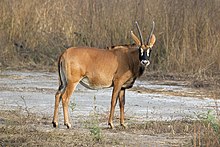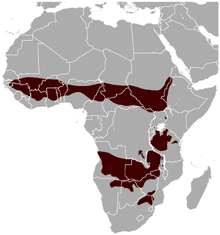| Roan antelope | |
|---|---|

| |
| H. e. equinus, Eswatini | |

| |
| H. e. koba in Senegal | |
| Scientific classification | |
| Domain: | Eukaryota |
| Kingdom: | Animalia |
| Phylum: | Chordata |
| Class: | Mammalia |
| Order: | Artiodactyla |
| Family: | Bovidae |
| Subfamily: | Hippotraginae |
| Genus: | Hippotragus |
| Species: | H. equinus
|
| Binomial name | |
| Hippotragus equinus (É. Geoffroy, 1803)
| |

| |
| range | |
| Synonyms[2] | |
|
List
| |
The roan antelope (Hippotragus equinus) is a large, savanna-dwelling antelope found in Western, Southern, and parts of Central and Eastern Africa.[3] Named for its roan colour (a slightly reddish, sandy-brown), it has a lighter-toned underbelly and a (mostly) white face and snout, but with a black "mask" around the eyes and on the bridge of the snout, being somewhat lighter in females. Additionally, a pair of formidable, recurved horns (made of keratin-covered bone) are present on the heads of both males and females, albeit larger on the males, growing up to 100 cm (39 in) long. Males and females have short, erect, mohawk-like manes running down their back and very light, shaggy neckbeards, both of which are more pronounced in males. Both mane and neckbeard are tinted with darker tips, which run the length of the animal's back and belly, ending in a dark-coloured tail. The ears are long, erect, and donkey-like.
The roan is among the world's largest antelopes, after the elands (Taurotragus sp.) and the nilgai (Boselaphus tragocamelus), measuring 190–240 cm (75–94 in) from the head to the base of the tail, with a 37–48 cm (15–19 in)-long tail. Males weigh upwards of 242–300 kg (534–661 lb) and females 223–280 kg (492–617 lb), with a shoulder height of around 130–140 cm (51–55 in).[4][5][6]
- ^ IUCN SSC Antelope Specialist Group (2017). "Hippotragus equinus". IUCN Red List of Threatened Species. 2017: e.T10167A50188287. doi:10.2305/IUCN.UK.2017-2.RLTS.T10167A50188287.en. Retrieved 11 November 2021.
- ^ Cite error: The named reference
MSW3was invoked but never defined (see the help page). - ^ "Roan Antelope". World Association of Zoos and Aquariums. Retrieved 14 April 2014.
- ^ ANIMAL BYTES – Roan Antelope. Seaworld.org. Retrieved on 10 October 2013.
- ^ Burnie D and Wilson DE (Eds.), Animal: The Definitive Visual Guide to the World's Wildlife. DK Adult (2005), ISBN 0789477645
- ^ Roan antelope videos, photos and facts – Hippotragus equinus Archived 14 June 2012 at the Wayback Machine. ARKive (28 June 2011). Retrieved on 2013-10-10.
